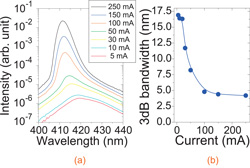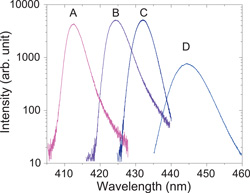
| Home | About Us | Contribute | Bookstore | Advertising | Subscribe for Free NOW! |
| News Archive | Features | Events | Recruitment | Directory |
News
1 June 2010
Nitride superluminescence expands blue–violet wavelength range
Extended performance for superluminescent light-emitting diodes (SLEDs) based in nitride semiconductor materials is reported by researchers in Switzerland [Marco Rossetti et al, Appl. Phys. Express, vol3, p061002, 2010]. Continuous-wave operation was achieved in the wider wavelength range 410–445nm, expanding on the 420nm of the first such nitride SLED presented by some of the same scientists last year (2009).
Half the research group was based at EXALOS, a Swiss company that develops and markets SLED-based modules and systems with wavelengths in the range 650–1650nm. Most of the remainder came from Ecole Polytechnique Fédérale de Lausanne. The Swiss nitride semiconductor epitaxy company Novagan was also involved in the research.
SLEDs are edge-emitting devices, rather like laser diodes (LDs), but with a larger LED-like bandwidth. The resulting emissions have high spatial coherence (with low speckle), but low temporal coherence. Their edge-emitting character gives them good coupling to external optical components and fibers. Possible applications include optical coherence tomography (OCT), fiber-optic gyroscopes (FOGs), testing of fiber-optic equipment, and speckle-free displays.
The coherence of the emitted light results from stimulated emission that occurs along the waveguide structure of the device. The broadband nature of the output occurs due to the suppression of feedback (reflection) and round-trip gain that normally would lead to narrow laser emission modes.
The SLED layers consisted of indium gallium nitride (InGaN) multi-quantum wells (MQWs) embedded in a p–n waveguide with aluminum gallium nitride (AlGaN) cladding. The layers were deposited using metal-organic chemical vapor deposition (MOCVD) on c-plane free-standing GaN substrates.
Ridges were formed using plasma etching. The output facets are designed to have low reflectivity by tilted cleaving of the ridge and the application of anti-reflective (AR) coatings. The temperature of the device during operation for most of the characterizations was controlled at 25°C, enabled by mounting single chips on copper or diamond heat spreaders.
 Figure 1: (a) Typical SLED spectra for varying injection current. (b) Corresponding bandwidth (FWHM) versus current injection (blobs, line is guide for eye).
Figure 1: (a) Typical SLED spectra for varying injection current. (b) Corresponding bandwidth (FWHM) versus current injection (blobs, line is guide for eye).
Along with pulsed and continuous light output power (L) testing, the researchers also studied coupling into single-mode optical fibers. At 150mA the coupling reached an ‘excellent’ maximum value of 55%. The pulsed operation tests suggest that thermal effects begin to adversely affect the operation of the device for currents greater than 250mA. Increased currents also lead to a narrowing of the spectrum of the SLED (Figure 1). This is attributed to the selective effects of single-pass amplification.
 Figure 2: High injection spectra of SLEDs with varying amount of indium in the active region.
Figure 2: High injection spectra of SLEDs with varying amount of indium in the active region.
The SLED output wavelength can be shifted by varying the indium content of the wells (Figure 2). Three devices achieved similar output powers at high injection, centered at 412nm, 424nm and 432nm with full-width at half-maximum (FWHM) of 4–5nm. The fourth device (D in Figure 2) had a lower power spectrum centered at 445nm, and a wider FWHM of ~8nm. The poorer performance of this last device is blamed on non-optimized growth conditions leading to degradation of the active region. The longer wavelength of D requires higher concentrations of indium, a factor that commonly reduces material quality and creates inhomogeneities that can affect the gain performance of MQW systems.
The thermal performance of the SLEDs was also tested by varying the heat-sink temperature in the range 20–100°C in pulsed operation. A characteristic temperature (T0) was defined from an exponential fit of the currents required to achieve 10mW output. The 140K value obtained is comparable to the characteristic temperature for threshold current of blue–violet laser diodes, indicating good thermal stability of the SLEDs.
Funding for the research came from the Swiss Innovation Promotion Agency and National Centers of Competence in Research (NCCR).
![]() Search: SLEDs InGaN MQWs
Search: SLEDs InGaN MQWs
Visit: http://apex.ipap.jp
Visit: www.exalos.com
Visit: www.novagan.com
Visit: http://laspe.epfl.ch
Visit: http://link.aip.org
The author Mike Cooke is a freelance technology journalist who has worked in the semiconductor and advanced technology sectors since 1997.